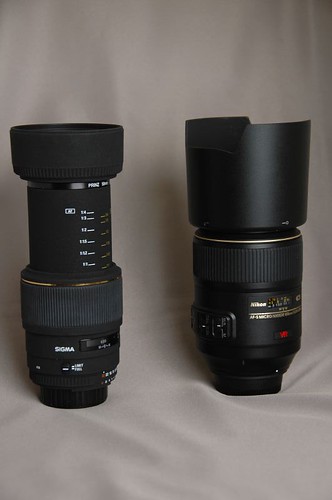
There are lots of ways to shoot macros (pictures at the end)
Macro lenses
The most logical one is to use a macro
lens. There are a lot of
macro lenses available. The important criteria to choose one is the
focal
distance influencing the working distance. The so called working
distance is in
fact the distance between the sensor (or film) plane and your subject,
typically
at a magnification factor 1:1. The magnification factor is the ratio
between the
size of the object and the size of the sensor. Be aware that a
published working
distance of for instance 30cm might seem a lot, but you have to
subtract the
length of the lens while fully extended to determine the distance
between the
front element of the lens and your subject... there comes the first
disappointment when you discover than with a so called working distance
of 30 cm
(one foot), your front element is in fact 5cm (2 inches) from your
subject.
This is important when you are shooting bugs, for instance. The longer
the focal
length the higher the "actual" working distance, i.e. the distance
subject-front element.
Now you have to choose the appropriate focal length. There are
typically 3
categories: 60mm, 100mm and 150mm and above.
60mm: this is the right length for product type
photography (jewels,
abstracts...)
The Nikkor 60mm is the classical choice
but Sigma has an
excellent 50mm lens too.
100mm: the most flexible length: products, bugs,
whatever...
There are lots of choices: Nikkor 105
VR, Nikkor 105 (AF or
manual versions), Tokina 100, Sigma 105, and Tamron 90
150mm and above: when you need more working distance,
excellent for bugs
Sigma 150, Sigma 180, Tamron 180....
An important thing: there is no such a thing as a bad macro lens. All
of them
are super sharp and excellent, differences are mainly build quality,
price and
brand image (Nikkor is the only one to have a stabilized one, the 105
VR) All of
them (one exception the Sigma 180 f3.5) are f2.8 lenses, that you can
also use
as general purpose fast lenses (typical application is portraiture).
A last thing, when shooting macro, you will use manual focus almost all
the time
(what I mean is that AF performance is not really relevant and that old
manual
lenses are also a possible choice - if they are compatible with your
body of
course)
See reviews of 105mm macro lenses here: Nikkor 105VR and Sigma 105
The Sigma lens next to the Nikkor 105VR lens - Sigma fully extended to reach a 1:1 magnification factor

Extension tubes
Those are basically cylinders with an
F-mount and possibly some
contacts to maintain metering and AF that you insert between a normal
lens and
the camera body.
Nikon has tubes, Kenko has good tubes that are cheap. They usually come
in kits
(3 different lengths allowing different combinations to get different
magnification factors).
I had excellent results combining tubes with a cheap 50mm f1.8 lens.
The advantage of tubes is that they are cheap and that they allow a
higher
magnification factor than a normal macro lens (up to 2:1 or even
slightly more
with the 50mm lens on the three Kenko tubes stacked together).
The 3 Kenko tubes (sold as a kit) 12-20 and 36 mm, they can be stacked to get 68mm
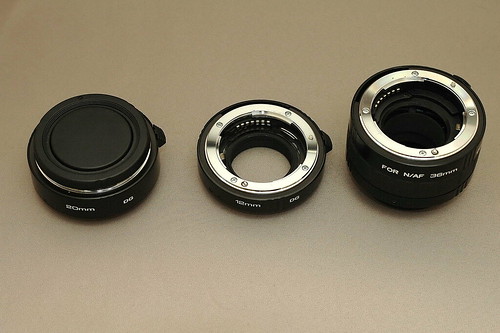
Close-up lenses
Another cheap and easy possibility is to
add a close-up lens to a zoom to get a versatile macro-enabled lens. There are several on the
market (Nikkor, Canon...). My favorite is the Canon 500D 77mm. It has to be mounted on
the front element of the lens like a filter and gives semi-macro capabilities.
Pictures are not exactly the same quality as with a real macro lens but very
close. The
advantage of the 77mm size is that you can mount it on typical good
zooms (70-200mm 2.8 or 80-400VR/OS) and with a step-up ring
(72mm->77mm) on a 18-200VR.
The limitation is that the magnification factor is determined by the
focal length (and proportional to it), you'll need a 500mm lens to get a 1:1
ratio.
About taking macro pictures
a few basic things: first of all at those short working
distances, your DOF is
close to zero, so you need to close down quite a lot but not too much
to avoid diffraction in the lens. The typical apertures used are f11-f16, f22 if
really necessary but not recommend. Since you close down so much, you'll need
a lot of light -> use a flash or several flashes to get the proper
lighting.
I use at least one serious flash like the SB-800 and preferably two
wireless
flashes mounted on a Manfrotto bracket. This gives the kind of light
you need.
Macro ring flashes have been developed specifically, but I don't
recommend them.
They are expensive, too specialized and they give a flat lighting
interesting
for surgery shots but not for the usual macro shots (don't buy one if
you are
not CSI ;-))
The last important thing that comes to mind is: use manual focus, or
don't use
focus at all. What I am typically doing is the following: I focus
manually, but
just approximately, and then I move the camera perpendicularly to the
subject
until I get a sharp picture. You can do that hand held or use a special
platform
on a tripod.
Example of a configuration with two wireless flashes on a bracket: (D70 and Sigma 105 f2.8)
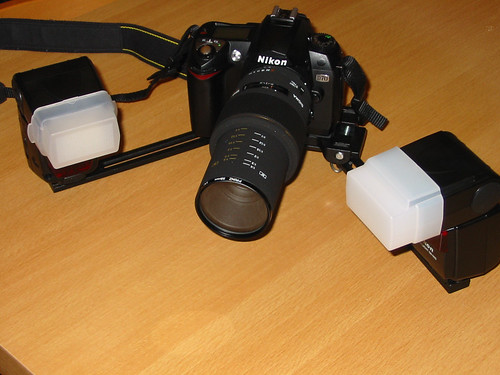
A few pictures (first two with one or two wireless flashes)
First one is a normal shot using a Sigma
105 lens on a D70
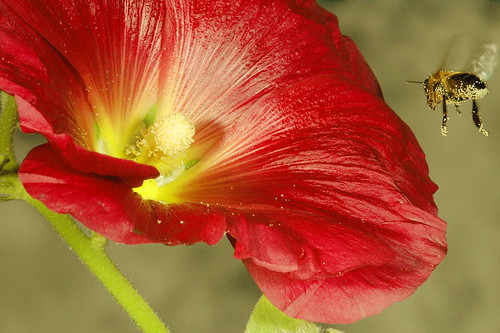
Second one is a high magnification one: extension tubes on a 50mm lens
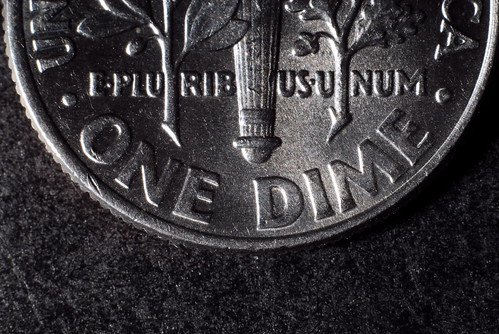
Third one is a 500D close-up lens on a 80-400mm OS lens
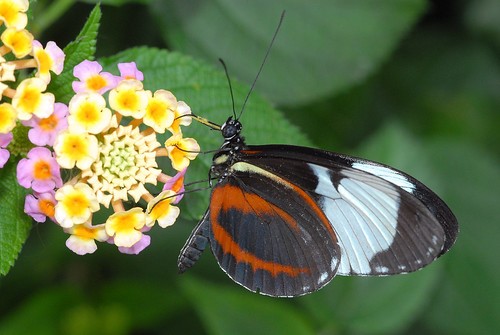
Last one shot handheld with the recent Nikkor 105VR - condensation on a metal plate - shot diagonally to play with DOF
